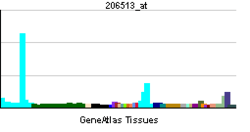AIM2
Interferon-inducible protein AIM2 also known as absent in melanoma 2 or simply AIM2 is a protein that in humans is encoded by the AIM2 gene.[1][2] Recent research has shown that AIM2 is part of the inflammasome and contributes to the defence against bacterial and viral DNA.[3]
Structure
AIM2 is a 343 amino acid protein with a N-terminal DAPIN (or pyrin) domain (amino acids 1-87) and a C-terminal HIN-200 domain (amino acids 138-337), which is known to have two oligonucleotide-binding folds.[4]
Function
AIM2 is a member of the Ifi202/IFI16 family. It plays a putative role in tumorigenic reversion and may control cell proliferation. Interferon-gamma induces expression of AIM2.[2]
Though there has been virtually no biochemistry performed, a model based on cell-based or in vivo experiments has led to the current model of how AIM2 triggers the inflammasome. The C-terminal HIN domain binds double stranded DNA (either viral, bacterial, or even host) and acts as a cytosolic dsDNA sensor. This leads to the oligomerization of the inflammasome complex. The N-terminal pyrin domain of AIM2 interacts with the pyrin domain of another protein ASC (or Apoptosis-associated Speck-like protein containing a caspase activation and recruitment domain). ASC also contains a CARD domain (caspase activation and recruitment domain), that recruits procaspase-1 to the complex. This leads to the autoactivation of caspase-1, an enzyme that processes proinflammatory cytokines (IL-1b and IL-18).[3]
Clinical relevance
Elevated levels of AIM2 expression are found in skin cells from people with psoriasis.[5]
References
- ↑ DeYoung KL, Ray ME, Su YA, Anzick SL, Johnstone RW, Trapani JA et al. (Aug 1997). "Cloning a novel member of the human interferon-inducible gene family associated with control of tumorigenicity in a model of human melanoma". Oncogene 15 (4): 453–7. doi:10.1038/sj.onc.1201206. PMID 9242382.
- ↑ 2.0 2.1 "Entrez Gene: AIM2 absent in melanoma 2".
- ↑ 3.0 3.1 Schroder K, Tschopp J (March 2010). "The inflammasomes". Cell 140 (6): 821–32. doi:10.1016/j.cell.2010.01.040. PMID 20303873.
- ↑ Fernandes-Alnemri T, Yu JW, Datta P, Wu J, Alnemri ES (March 2009). "AIM2 activates the inflammasome and cell death in response to cytoplasmic DNA". Nature 458 (7237): 509–13. doi:10.1038/nature07710. PMC 2862225. PMID 19158676.
- ↑ Dombrowski Y, Peric M, Koglin S, Kammerbauer C, Göss C, Anz D et al. (May 11, 2011). "Cytosolic DNA triggers inflammasome activation in keratinocytes in psoriatic lesions". Sci Transl Med 3 (82): 82ra38. doi:10.1126/scitranslmed.3002001. PMC 3235683. PMID 21562230. Vancouver style error (help)
Further reading
- Landolfo S, Gariglio M, Gribaudo G, Lembo D (1999). "The Ifi 200 genes: an emerging family of IFN-inducible genes". Biochimie 80 (8-9): 721–8. doi:10.1016/S0300-9084(99)80025-X. PMID 9865494.
- Woerner SM, Kloor M, Schwitalle Y, Youmans H, Doeberitz M, Gebert J et al. (2007). "The putative tumor suppressor AIM2 is frequently affected by different genetic alterations in microsatellite unstable colon cancers". Genes Chromosomes Cancer 46 (12): 1080–9. doi:10.1002/gcc.20493. PMID 17726700.
- Chen IF, Ou-Yang F, Hung JY, Liu JC, Wang H, Wang SC et al. (2006). "AIM2 suppresses human breast cancer cell proliferation in vitro and mammary tumor growth in a mouse model". Mol. Cancer Ther. 5 (1): 1–7. doi:10.1158/1535-7163.MCT-05-0310. PMID 16432157.
- Cresswell KS, Clarke CJ, Jackson JT, Darcy PK, Trapani JA, Johnstone RW (2005). "Biochemical and growth regulatory activities of the HIN-200 family member and putative tumor suppressor protein, AIM2". Biochem. Biophys. Res. Commun. 326 (2): 417–24. doi:10.1016/j.bbrc.2004.11.048. PMID 15582594.
- Liu G, Yu JS, Zeng G, Yin D, Xie D, Black KL et al. (2004). "AIM-2: a novel tumor antigen is expressed and presented by human glioma cells". J. Immunother. 27 (3): 220–6. doi:10.1097/00002371-200405000-00006. PMID 15076139.
- Choubey D, Walter S, Geng Y, Xin H (2000). "Cytoplasmic localization of the interferon-inducible protein that is encoded by the AIM2 (absent in melanoma) gene from the 200-gene family". FEBS Lett. 474 (1): 38–42. doi:10.1016/S0014-5793(00)01571-4. PMID 10828447.
